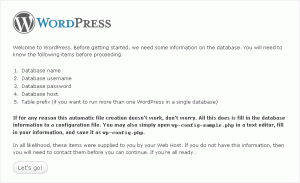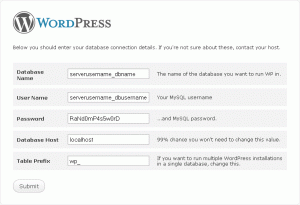Maybe I’m slow, but I just discovered “php.ini QuickConfig” in cPanel 11. It probably exists in prior versions too. It was hidden under “Software / Services”. Most of the default settings should be fine, but you might want to disable register_globals if it isn’t disabled already. This will prevent malicious visitors from setting your PHP variables themselves by attaching arguments to the URL. Just make sure you always use $_GET and $_POST where ever it’s necessary.
How To Create a Database and Install WordPress
This tutorial isn’t just about installing WordPress. It will cover how to set up a database using cpanel, and optionally, how to unzip files directly on your web server.
WordPress has documentation on their site about installation too, but I’m going to share with you how I like to do it.
The Easy Way
Estimated Time: 15 minutes
Skill Level Required: Beginner
Requirements:
- Access to a web server (FTP and cpanel)
- An FTP client
Steps:
- Download WordPress. Go to wordpress.org/download and click Download WordPress. Save the zip file to somewhere on your computer. The desktop works well (you can delete it in a minute).
- Unzip it. Find the file on your computer, right-click it and click “extract here”. If you don’t have an option like that, you might need a file (un)archiver. I like WinRar, but 7-Zip is free. This will create a folder called “wordpress” on your desktop.
- Upload it. Open your FTP client (FileZilla is free if you need one), and connect to your web server. You will need a server address (your domain), a username, and password to do this. After you’ve connected, upload all the files inside the WordPress folder (don’t upload the folder itself unless you want WordPress to be located at yoursite.com/wordpress). You probably want to put these files inside the “www” or “public_html” folder on your web server. If there are a bunch of files in there already, they might conflict with WordPress; consider deleting them or moving them to a subfolder.
Note: I’m not responsible if your web server explodes or anything else bad happens. - Create a configuration file. Go to yoursite.com. You should be presented with a screen that looks something like this (from WordPress 2.7)
 Ignore the warning and click the big round “Create a Configuration File” button. It should work for most setups (if it doesn’t, you’d better follow their instructions, not mine).
Ignore the warning and click the big round “Create a Configuration File” button. It should work for most setups (if it doesn’t, you’d better follow their instructions, not mine). - Next. Ignore the pretty text on the next page, and click “Let’s go!”

- Setup the database. Now it’s going to ask you for a bunch of info. If you don’t know what to put here, I can tell you how to set it up if your web host is using cpanel. Open yoursite.com/cpanel in a new tab/window. If you get a 404 or something like that, talk to someone else 🙂 If it asks you for your username and password, enter it. Depending on the version of cpanel, you should be presented with a bunch of icons. Find the one that says “MySQL Databases” and click it. We’re going to create a new database for WordPress so that we don’t accidentally muck anything else up. Near the top of the page there should an area to “create a new database”. Enter something clever like “wordpress” or “mysite” and create the database.

Scroll down to where it says “add new user”. Choose a username and password, and create a user. You might as well make your password a bunch of random upper and lowercase letters, numbers, and symbols. You should only need to enter this password once after it’s created. Now, scroll past “add new user” to “add user to database”. Choose the username and database you just created, then click “add”. If the username and database have another username before it, make note of this; you will need to enter these into the WordPress installation form.

- Fill in the WordPress form. Great, your database is set up. Now you can fill in that old form. Enter the database name, user name and password you just chose (with the prefixes if it added them). You shouldn’t need to change the database host or table prefix. Click “Submit”.

- You’re done. You can listen to WordPress now 🙂 It will guide you through the rest.
The Faster Way
WordPress 2.7 is 1.76 MB compressed, or 5.38 MB uncompressed with 603 files. I find it considerably faster to upload just the zip file.
Estimated Time: 10 minutes
Skill Level Required: Novice
Requirements:
- Access to a web server (FTP, cpanel, and shell)
- An FTP client
Assumptions:
- You can follow the steps above
- You’re on a linux server, but have no knowledge of linux
Steps:
- Download WordPress.
- Don’t unzip it.
- Upload the zip file.
- Open up PuTTY or your favorite SSH program.
- Connect to your web server. If you’re on HostGator like me, you can find the IP Address on the left sidebar of your cpanel, under “Account Information”. The Port is 2222. You may need to ask Tech Support to enable Jailed SSH for you though.
- Enter your username and password. If you’re new to this, your password won’t appear as you type (no asterisks, nothing).
- Type the following commands. You can use tab to auto-complete folder and filenames. Adjust the file/folder names below as needed. Use the “ls” (list directory contents) and “pwd” (print working directory) commands to figure out where you are, if you get lost. Also, “man <command>” will give you more information about a particular command.
cd public_html/<folder-where-you-uploaded-wordpress>
unzip wordpress-2.7.zip
mv wordpress/* .
rm wordpress-2.7.zip
rmdir wordpress - Follow steps 4 onward, above.
That’s it for this tutorial, I hope you enjoyed it!